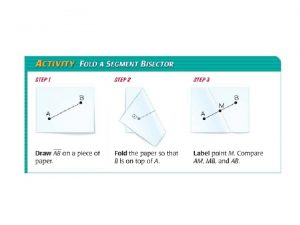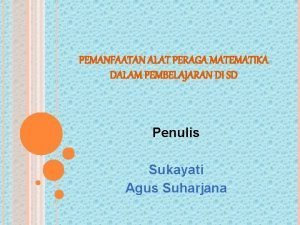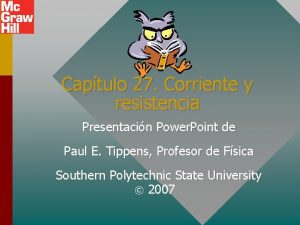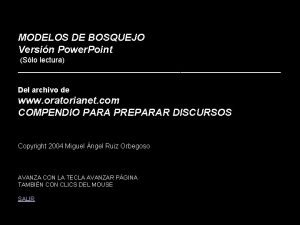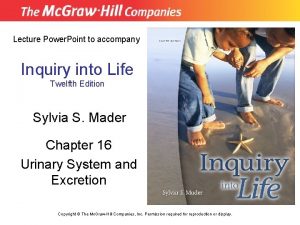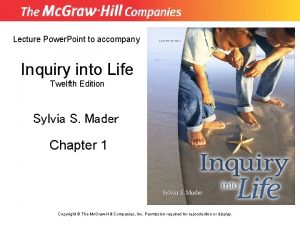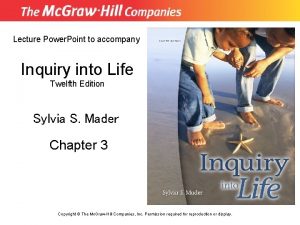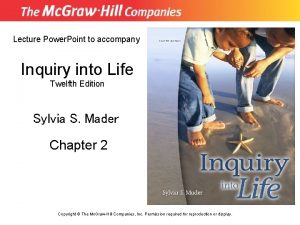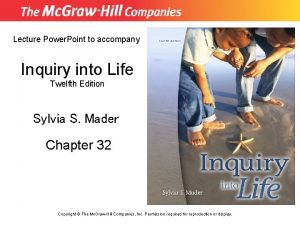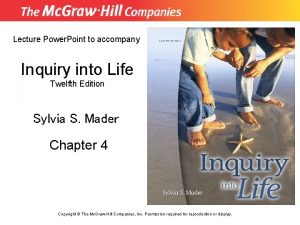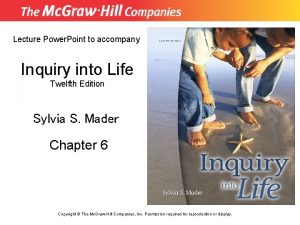Lecture Power Point to accompany Inquiry into Life




























































- Slides: 60

Lecture Power. Point to accompany Inquiry into Life Twelfth Edition Sylvia S. Mader Chapter 5 Copyright © The Mc. Graw-Hill Companies, Inc. Permission required for reproduction or display.

5. 1 Cell Increase and Decrease • Cell division increase the number of somatic cells (body cells)

5. 1 Cell Increase and Decrease • Cell division increase the number of somatic cells (body cells) Zygote Trillions of cells

5. 1 Cell Increase and Decrease • Cell division increase the number of somatic cells (body cells) – Mitosis: Division of the nucleus

5. 1 Cell Increase and Decrease • Cell division increase the number of somatic cells (body cells) – Mitosis: Division of the nucleus – Cytokinesis: Division of the cytoplasm

5. 1 Cell Increase and Decrease • Cell division increase the number of somatic cells (body cells) – Mitosis: Division of the nucleus – Cytokinesis: Division of the cytoplasm – Apoptosis: Programmed cell death

5. 1 Cell Increase and Decrease • The Cell Cycle – Orderly set of stages that occur between the time a cell divides and the time the resulting daughter cells divide

5. 1 Cell Increase and Decrease • The Cell Cycle – Interphase • G 1 • S • G 2 – Mitotic Stage • Mitosis and Cytokinesis

5. 1 Cell Increase and Decrease • The Cell Cycle – Interphase • G 1 • S • G 2 – Mitotic Stage • Mitosis and Cytokinesis

The Cell Cycle

5. 1 Cell Increase and Decrease • Control of the Cell Cycle – Internal and External Signals • Signaling proteins called cyclins increase and decrease as the cell cycle continues – Three Checkpoints • G 1 • G 2 • M

The Cell Cycle

5. 1 Cell Increase and Decrease • Apoptosis – Cells undergo programmed cell death when they cannot complete mitosis or in response to external signals.

Apoptosis

5. 2 Maintaining the Chromosome Number

5. 2 Maintaining the Chromosome Number • Terms: – Chromatin: tangled mass of threadlike DNA in a non-dividing cell

5. 2 Maintaining the Chromosome Number • Terms: – Chromatin: tangled mass of threadlike DNA in a non-dividing cell – Chromosomes: condensed DNA molecules observed in dividing cells

5. 2 Maintaining the Chromosome Number • Terms: – Chromatin: tangled mass of threadlike DNA in a non-dividing cell – Chromosomes: condensed DNA molecules observed in dividing cells – Diploid (2 n): Cells have two (a pair) of each type of chromosome

5. 2 Maintaining the Chromosome Number • Terms: – Chromatin: tangled mass of threadlike DNA in a non-dividing cell – Chromosomes: condensed DNA molecules observed in dividing cells – Diploid (2 n): Cells have two (a pair) of each type of chromosome – Haploid (1 n): Cells have half the diploid number of chromosomes

5. 2 Maintaining the Chromosome Number • Overview of Mitosis – Nuclear division in which chromosome number stays constant – DNA replication produces duplicated chromosomes – Each duplicated chromosome is composed of 2 sister chromatids held together by a centromere – Sister chromatids are genetically identical – During mitosis, the centromere divides and each chromatid becomes a daughter chromosome

Chromosomes and Chromatids

Mitosis Overview

5. 2 Maintaining the Chromosome Number • Mitosis in Detail - Animal Cells – Prophase-nuclear membrane disappears, centrosomes migrate, spindle fibers appear – Metaphase-chromosomes line up at metaphase plate, associated with spindle fibers – Anaphase-centromeres divide, sister chromatids migrate to opposite poles, cytokinesis begins – Telophase-nuclear membranes form, spindle disappears, cytokinesis occurs

Mitosis in Detail - Animal Cells

5. 2 Maintaining the Chromosome Number • How Plant Cells Divide – Occurs in meristematic tissues – Same phases as animal cells – Plant cells do not have centrioles or asters

Mitosis in Detail - Plant Cells

5. 2 Maintaining the Chromosome Number • Cytokinesis in Plant Cells – Flattened, small disk appears between daughter cells – Golgi apparatus produces vesicles which move to disk – Release molecules which build new cell walls – Vesicle membranes complete plasma membranes

Cytokinesis in Plant Cells

5. 2 Maintaining the Chromosome Number • Cytokinesis in Animal Cells • Cleavage furrow forms between daughter nuclei • Contractile ring contracts deepening the furrow • Continues until separation is complete

Cytokinesis in Animal Cells

5. 2 Maintaining the Chromosome Number • Cell Division in Prokaryotes: Binary Fission – – Prokaryotes have a single chromosome Chromosomal replication occurs before division Cell begins to elongate to twice its length Cell membrane grows inward until division is complete

Binary Fission

5. 3 Reducing the Chromosome Number

5. 3 Reducing the Chromosome Number • Meiosis – Occurs in the life cycle of sexually reproducing organisms – Reduces the chromosome number – Provides offspring with a different combination of traits from that of either parent

5. 3 Reducing the Chromosome Number • Overview of Meiosis – 2 divisions, 4 daughter cells – Cells are diploid at beginning of meiosis – Pairs of chromosomes are called homologues

5. 3 Reducing the Chromosome Number • Overview of Meiosis – Meiosis I • Homologues line up side by side at equatorsynapsis • When pairs separate, each daughter cell receives one member of the pair • Cells are now haploid

Meiosis

5. 3 Reducing the Chromosome Number • Overview of Meiosis – Meiosis II • No replication of DNA occurs in this division • Centromeres divide and sister chromatids migrate to opposite poles to become individual chromosomes • Each of the four daughter cells produced has the haploid chromosome number and each chromosome is composed of one chromatid

Meiosis

5. 3 Reducing the Chromosome Number • Overview of Meiosis – Fertilization • Fertilization restores the diploid number of chromosomes in a cell that will develop into a new individual.

5. 3 Reducing the Chromosome Number • Meiosis in Detail – Genetic Recombination Occurs in Two Ways • Crossing Over • Independent Assortment

Crossing Over

Independent Assortment

5. 3 Reducing the Chromosome Number • Phases of Meiosis I – Prophase I • Synapsis occurs, nuclear membrane breaks down • Homologues line up side by side and crossing over occurs – Metaphase I • Homologous pairs line up at metaphase plate such that maternal or paternal member may be oriented toward either pole

5. 3 Reducing the Chromosome Number • Phases of Meiosis I • Anaphase I • Homologous chromosomes (each still consisting of 2 chromatids) undergo independent assortment into daughter cells – Telophase I • Cytokinesis produces 2 daughter cells which are haploid

Phases of Meiosis I • Fig 5. 12

5. 3 Reducing the Chromosome Number • Interkinesis - period of time between Meiosis I and Meiosis II • Phases of Meiosis II – Prophase II • Cells have one member of each homologous pair – Metaphase II • Chromosomes line up at the metaphase plate

5. 3 Reducing the Chromosome Number • Phases of Meiosis II – Anaphase II • Centromeres divide and daughter chromosomes migrate – Telophase II • Nuclei form, cytokinesis

Phases of Meiosis II • Fig 5. 13

5. 3 Reducing the Chromosome Number • Nondisjunction – The failure of paired chromosomes or chromatids to separate during cell division – Results in cells with an abnormal number of chromosomes – Trisomy 21 (Down syndrome) is an example

5. 3 Reducing the Chromosome Number • Genetic Recombination – Promotes genetic variability – Independent assortment of paired chromosomes during metaphase I – Crossing over in prophase I – Both assure that gametes will contain different combinations of chromosomes – When fertilization occurs, the resulting offspring will be genetically unique

Comparison of Meiosis to Mitosis • DNA replication occurs only once prior to either meiosis and mitosis • Meiosis requires two divisions, mitosis only one • Meiosis produces four daughter cells, mitosis produces two • Daughter cells from meiosis are haploid, those from mitosis are diploid • Daughter cells from meiosis are genetically variable, while those from mitosis are genetically identical

Comparison of Meiosis to Mitosis

5. 5 The Human Life Cycle • Requires both mitosis and meiosis • Meiosis in the female is called oogenesis • Meiosis in the male is called spermatogenesis • At fertilization, the resulting zygote divides by mitosis for the processes of growth and development • Mitosis is used for repair throughout life

Life Cycle of Humans

5. 5 The Human Life Cycle • Spermatogenesis – Begins at puberty and continues throughout life – Primary spermatocytes (2 n) divide in meiosis I to form two secondary spermatocytes (1 n) – Secondary spermatocytes divide in meiosis II to produce four sperm

5. 5 The Human Life Cycle • Oogenesis – Begins in the fetus • Primary oocytes are arrested in prophase I – At puberty, one primary oocyte continues the process of meiosis during each menstrual cycle – Primary oocyte (2 n) divides in meiosis I to produce one secondary oocyte (1 n) and one polar body • Division is unequal as secondary oocyte receives most of the cell contents and half the chromosomes

5. 5 The Human Life Cycle • Oogenesis – If the secondary oocyte is fertilized, meiosis II will proceed. • Another unequal division will occur, the egg receiving most of the cytosplasm. A second polar body is also formed. – The unequal divisions allows the egg to have all the cellular “machinery” it needs for embryonic development

Spermatogenesis and Oogenesis in Mammals

5. 5 The Human Life Cycle • Summary – Spermatogenesis and oogenesis both utilize meiosis – Spermatogenesis begins at puberty and continues throughout life – Spermatogenesis produces one sperm per primary spermatocyte • Results in production of many sperm – Oogenesis results in one oocyte and up to three polar bodies per primary oocyte • Divisions are unequal, ovum receives most cell contents – Oogenesis begins prior to birth, stops until puberty, then resumes in a cyclic pattern – Cyclic release of oocytes continues until menopause when the process stops
 Median cubital vein
Median cubital vein Hebrews 6:9-12 sermon
Hebrews 6:9-12 sermon Accompany chapter 1
Accompany chapter 1 Accompany
Accompany 01:640:244 lecture notes - lecture 15: plat, idah, farad
01:640:244 lecture notes - lecture 15: plat, idah, farad Power triangle
Power triangle Power bi training powerpoint
Power bi training powerpoint Point point power
Point point power The detectives need more time to inquire
The detectives need more time to inquire Power system dynamics and stability lecture notes
Power system dynamics and stability lecture notes Power system analysis lecture notes
Power system analysis lecture notes Power semiconductor devices lecture notes
Power semiconductor devices lecture notes Switch mode power supply lecture notes
Switch mode power supply lecture notes Power system dynamics and stability lecture notes
Power system dynamics and stability lecture notes Things fall apart customs
Things fall apart customs Life lecture meaning
Life lecture meaning Drawing the power of jesus christ into our lives
Drawing the power of jesus christ into our lives Invisibility flight the power to split into multiple bodies
Invisibility flight the power to split into multiple bodies Why did japan turn itself into an imperialist power?
Why did japan turn itself into an imperialist power? A high point of land extending into water
A high point of land extending into water The point that divides a segment into two
The point that divides a segment into two Solar power satellites and microwave power transmission
Solar power satellites and microwave power transmission Potential power
Potential power Flex power power supply
Flex power power supply Dispersive power of a grating is
Dispersive power of a grating is Power of a power property
Power of a power property Chain rule範例
Chain rule範例 Power angle curve in power system stability
Power angle curve in power system stability Power absorbed or delivered
Power absorbed or delivered People come in your life for a reason
People come in your life for a reason Life is divided into three terms
Life is divided into three terms Evangelio del domingo en power point
Evangelio del domingo en power point Ejemplos de ova en power point
Ejemplos de ova en power point La boutique del power point rincones del mundo
La boutique del power point rincones del mundo Presentazione tennis
Presentazione tennis Tm pp
Tm pp Power point sul riciclo in inglese
Power point sul riciclo in inglese Blok dienes
Blok dienes Sekolah sabat powerpoint
Sekolah sabat powerpoint La boutique del power point x
La boutique del power point x La boutique del power point
La boutique del power point La boutique del power point
La boutique del power point La boutique del powerpoint
La boutique del powerpoint Gizi kuliner adalah
Gizi kuliner adalah Decreto 1330 de 2019 ppt
Decreto 1330 de 2019 ppt Powerpoint
Powerpoint Barcanova
Barcanova Cara mengoperasikan powerpoint
Cara mengoperasikan powerpoint Potencia electrica formulas
Potencia electrica formulas Disadvantages of powerpoint
Disadvantages of powerpoint Ventajas de power point
Ventajas de power point Presentazione power point tesina
Presentazione power point tesina La boutique del powerpoint x
La boutique del powerpoint x Rambu-rambu penyusunan materi ajar adalah
Rambu-rambu penyusunan materi ajar adalah Power point fisica
Power point fisica Power point
Power point Concentrese en power point
Concentrese en power point Modelos de bosquejo
Modelos de bosquejo Powerpoint sugli egizi
Powerpoint sugli egizi La boutique del powerpointx
La boutique del powerpointx La boutique del power point x
La boutique del power point x




















